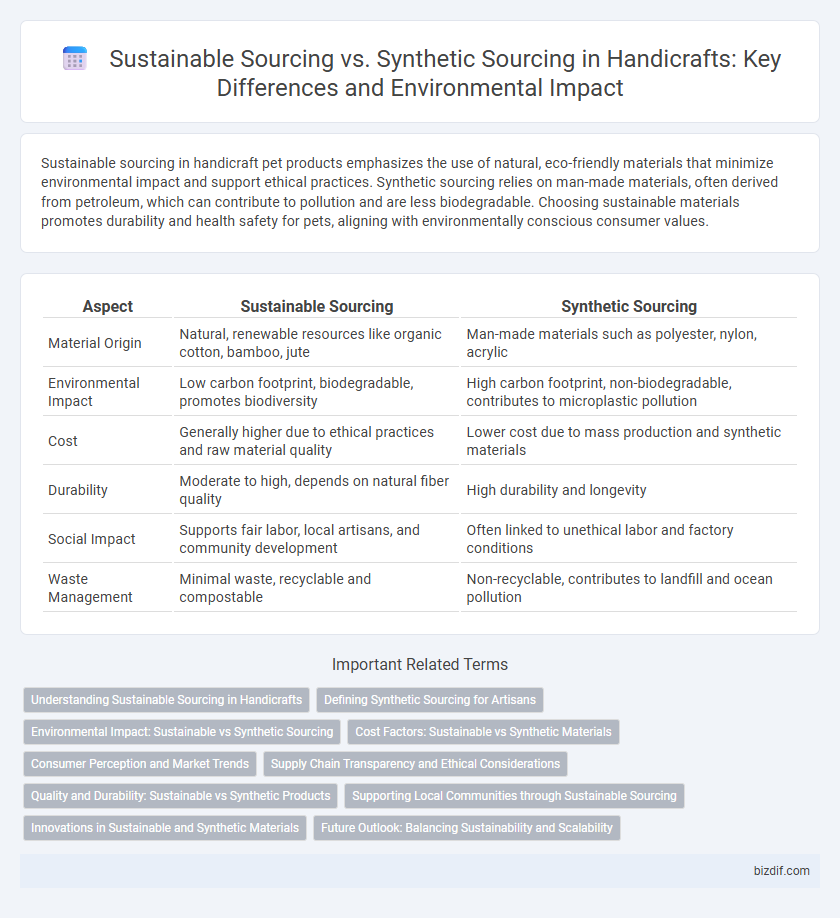Sustainable sourcing in handicraft pet products emphasizes the use of natural, eco-friendly materials that minimize environmental impact and support ethical practices. Synthetic sourcing relies on man-made materials, often derived from petroleum, which can contribute to pollution and are less biodegradable. Choosing sustainable materials promotes durability and health safety for pets, aligning with environmentally conscious consumer values.
Table of Comparison
| Aspect | Sustainable Sourcing | Synthetic Sourcing |
|---|---|---|
| Material Origin | Natural, renewable resources like organic cotton, bamboo, jute | Man-made materials such as polyester, nylon, acrylic |
| Environmental Impact | Low carbon footprint, biodegradable, promotes biodiversity | High carbon footprint, non-biodegradable, contributes to microplastic pollution |
| Cost | Generally higher due to ethical practices and raw material quality | Lower cost due to mass production and synthetic materials |
| Durability | Moderate to high, depends on natural fiber quality | High durability and longevity |
| Social Impact | Supports fair labor, local artisans, and community development | Often linked to unethical labor and factory conditions |
| Waste Management | Minimal waste, recyclable and compostable | Non-recyclable, contributes to landfill and ocean pollution |
Understanding Sustainable Sourcing in Handicrafts
Sustainable sourcing in handicrafts emphasizes the use of renewable, ethically harvested materials that minimize environmental impact and support local communities. This approach promotes biodiversity conservation and reduces carbon footprints compared to synthetic sourcing, which often relies on non-renewable, petrochemical-based materials. Embracing sustainable sourcing enhances the authenticity and cultural value of handicrafts while fostering eco-friendly production practices.
Defining Synthetic Sourcing for Artisans
Synthetic sourcing for artisans involves obtaining raw materials that are artificially manufactured rather than naturally derived, such as synthetic fibers, plastics, or lab-created gemstones. These materials offer consistent quality, cost efficiency, and greater availability, enabling artisans to produce durable and uniform handicrafts at scale. The use of synthetic sources contrasts with sustainable sourcing, which prioritizes natural, eco-friendly, and ethically obtained materials to minimize environmental impact.
Environmental Impact: Sustainable vs Synthetic Sourcing
Sustainable sourcing in handicraft prioritizes environmentally friendly materials that minimize deforestation, pollution, and carbon emissions, promoting biodiversity and ecosystem health. Synthetic sourcing often relies on petrochemicals and non-renewable resources, contributing to higher carbon footprints, toxic waste, and microplastic pollution. Choosing sustainable materials reduces environmental degradation and supports circular economy principles, making a crucial difference in eco-conscious handicraft production.
Cost Factors: Sustainable vs Synthetic Materials
Sustainable sourcing in handicraft often involves higher upfront costs due to the use of organic, renewable materials and ethical labor practices, which can increase production expenses. Synthetic sourcing offers lower material costs and consistent supply chains, making it economically attractive for large-scale manufacturing. However, the long-term environmental impact and potential regulatory costs of synthetic materials may offset initial savings compared to sustainable alternatives.
Consumer Perception and Market Trends
Sustainable sourcing in handicrafts enhances consumer trust by emphasizing eco-friendly materials and ethical labor practices, aligning with growing demand for authenticity and environmental responsibility. Synthetic sourcing often appeals to cost-conscious markets due to affordability and consistency but may face skepticism regarding environmental impact and craftsmanship value. Market trends increasingly favor sustainably sourced products as customers prioritize transparency and long-term sustainability over cheaper synthetic alternatives.
Supply Chain Transparency and Ethical Considerations
Sustainable sourcing in handicrafts prioritizes transparency in the supply chain, ensuring materials are ethically obtained from renewable or biodegradable resources, which supports fair labor practices and environmental stewardship. Synthetic sourcing often lacks this transparency, relying on mass-produced, non-renewable materials that may involve exploitative labor conditions and contribute to pollution. Ethical considerations in sustainable sourcing encompass the full lifecycle of handcrafted products, promoting social responsibility and reducing ecological impact compared to synthetic alternatives.
Quality and Durability: Sustainable vs Synthetic Products
Sustainable sourcing in handicrafts prioritizes natural materials like bamboo, organic cotton, and reclaimed wood, resulting in products known for superior quality and long-lasting durability. Synthetic sourcing often relies on plastics and man-made fibers that may degrade faster and contribute to environmental waste. Handicraft items crafted from sustainably sourced materials consistently demonstrate enhanced strength, resilience, and eco-friendly attributes compared to their synthetic counterparts.
Supporting Local Communities through Sustainable Sourcing
Sustainable sourcing in handicrafts prioritizes using natural, locally-sourced materials that preserve environmental integrity and cultural heritage. This approach strengthens local economies by providing artisans with fair wages and promoting traditional craftsmanship. Unlike synthetic sourcing, which often relies on mass-produced, environmentally harmful materials, sustainable sourcing fosters long-term community resilience and eco-friendly practices.
Innovations in Sustainable and Synthetic Materials
Innovations in sustainable materials for handicrafts include biodegradable fibers derived from bamboo, hemp, and organic cotton, reducing environmental impact while maintaining durability and aesthetic appeal. Synthetic sourcing advances incorporate bio-based polymers and recycled plastics that offer enhanced strength, versatility, and cost-efficiency, catering to mass production and customizable designs. The integration of eco-friendly dyes and non-toxic adhesives further exemplifies the shift towards sustainability in both natural and synthetic material sourcing for handcrafted products.
Future Outlook: Balancing Sustainability and Scalability
Sustainable sourcing in handicraft emphasizes eco-friendly materials and ethical labor, ensuring long-term environmental and social benefits, while synthetic sourcing offers scalability and cost-efficiency through mass production. The future outlook involves integrating innovative sustainable practices with scalable synthetic methods to meet growing demand without compromising ecological responsibility. Advancements in bio-based synthetics and circular supply chains will play a critical role in achieving this balance.
Sustainable Sourcing vs Synthetic Sourcing Infographic

 bizdif.com
bizdif.com